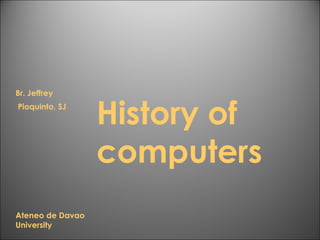
History of computers
- 1. History of computers Br. Jeffrey Pioquinto, SJ Ateneo de Davao University
- 2. history Looking at our past so as we can better understand today and plan well for the future.
- 3. Those who cannot remember the past are condemned to repeat it. GEORGE SANTAYANA
- 10. Technology is: anything that wasn’t around when you were born. ALAN KAY
- 11. operate the machine Consider these planes (an ancient tool): their designers sought fitness for use, ease of use, good control, long-lasting materials, a good feel in the hand, efficiency of operation, precise adjustment. In use over time, these tools come to be loved by their owners.
- 12. pre-computer Most of the qualities we seek in a machine have been valued through the ages. • useful • usable • desirable • affordable for the right people • appropriately complex • appropriately styled • appropriately adaptable, extensible, malleable • overall, having “good fit” with people, context, activity, result
- 14. characteristic statement of the time The abacus, also called a counting frame, is a calculating tool used primarily in parts of Asia for performing arithmetic processes
- 16. mechanical1650 1940 Pascaline – first mechanical computing machines
- 17. electronic1940 1960 Vacuum tubes invented = transition to electronics
- 18. electronic1940 1960 ENIAC (first electronic computer) – 1946
- 19. electronic1940 1960 1948 – transistor invented (replaced vaccuum tubes)
- 20. mini1960 1975 Integrated circuits are born equivalent of millions of transistors
- 22. the mac taps into pent-up desire for ease and pleasure of use Then, during the 1984 Superbowl, you see the first commercial for the Macintosh (directed by Ridley Scott of Blade Runner fame). A crowd of solemn men is gathered in a gloomy auditorium, listening to a ranting bureaucrat on a huge screen. Think of a world full of command-line interfaces… An athletic woman in colorful clothing runs into the auditorium, carrying a huge hammer… …which she throws into the screen, smashing the image and voice of the status quo. hello.
- 24. Ergonomic tips in using computers Ergonomics is the science of designing the job, equipment, and workplace to fit the worker. Proper ergonomic design is necessary to prevent repetitive strain injuries, which can develop over time and can lead to long-term disability
- 33. An ounce of Prevention is worth a pound of cure !
Notes de l'éditeur
- prehistory
- Operation Barbarossa – 1941 Hitler decides to invade Russia Blitzkreig -> all over by late Sep 1941 Reasons for failure: 1) logistics – speed left support for front line troops lagging far behind 2) resilience of Soviet forces 3) brutal weather
- Operation Barbarossa – 1941 Hitler decides to invade Russia Blitzkreig -> all over by late Sep 1941 Reasons for failure: 1) logistics – speed left support for front line troops lagging far behind 2) resilience of Soviet forces 3) brutal weather
- Operation Barbarossa – 1941 Hitler decides to invade Russia Blitzkreig -> all over by late Sep 1941 Reasons for failure: 1) logistics – speed left support for front line troops lagging far behind 2) resilience of Soviet forces 3) brutal weather
- May 1942, Winston Churchill There is a winter, you know, in Russia," he said. "For a good many months the temperature is apt to fall very low. There is snow, there is frost, and all that. Hitler forgot about this Russian winter. He must have been very loosely educated. We all heard about it at school; but he forgot it. I have never made such a bad mistake as that."
- 1812 – Napoleon invaded Russia At the time invincible, but returned with 40K of his original army of 640K Problems? 1) logisitics – used to foraging & forced marches, here left animals + soldiers dead 2) resilience of soviet forces – continuous retreat / regrouping & burning fields
- prehistory
- prehistory
- Led to development of commerce + math previously one for one matching to count / add / subtract
- Pascaline – first mechanical computing machines (1642)
- Vacuum tubes invented = transition to electronics
- ENIAC (first electronic computer) – 1946 designed for military could not store programs Designed for military & first used in calculations for atomic bomb
- 1948 – transistor invented (replaced vaccuum tubes)Huge size difference
- Integrated circuits are born equivalent of millions of transistors
- Internet is becoming new super computer - shared
